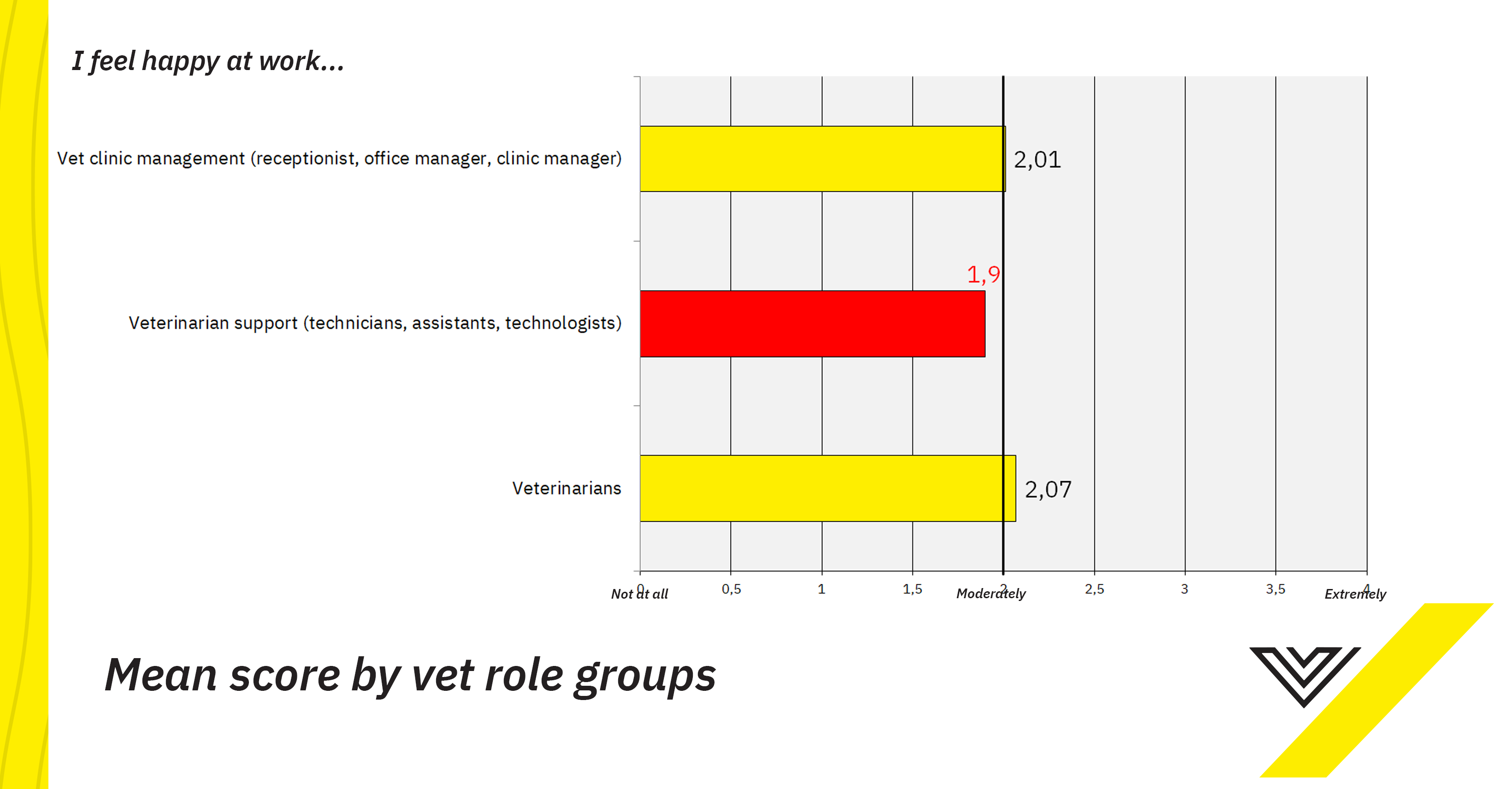Veterinary Technicians Under Stress: The Highest Level of Burnout in The Survey
We are releasing the second part of the Burnout Survey, conducted as part of Dr. Ivan Zak’s MBA dissertation, “Lean Thinking in Veterinary Organizations to Improve Employee Experience.” The first part of the research confirmed the growing problem of burnout in the veterinary domain. It revealed that younger veterinary professionals show more signs of compassion fatigue than their older colleagues. The second part of the report investigates the problem from different veterinary roles perspective.
The survey revealed that veterinary technicians have a dangerously low level of job satisfaction, which is substantially worse than the doctor’s satisfaction rate.
To compare different roles of veterinarians, all participants responded to the same statement: ‘I feel happy at work … “ While analyzing results, Dr. Zak made an alarming discovery — there is a dangerously low level of job satisfaction among veterinary technicians — which is significantly worse than the satisfaction rate of the veterinarians.
A minor part of the survey consisted of veterinary assistants and “non-vets,” which contributed to the study’s success. Even though only a small percentage of non-vets (office managers, receptionists, clinic managers, etc.) participated in the study, they also experienced burnout. Their roles in the whole clinical experience for clients and patients should not be underestimated. That is another reason why it was crucial to include and analyze more diverse groups in this study.
The COVID-19 pandemic is also having negative impacts on the mental health and well-being of veterinary professionals. With Stephen Cital’s help, Dr. Zak conducted a poll in Veterinary Anesthesia Nerds, one of the most significant veterinary technician communities in North America, which showed that 78 percent of respondents have been feeling stressed out at work more than usual since the coronavirus pandemic started (1,120 out of 1,431 votes).
Why do Veterinary Technicians have a higher rate of Burn out than veterinarians?
There are a few reasons that technicians may feel burn out more than veterinarians.
- They work long hours. While veterinarians work long hours too, usually veterinary technicians arrive to work before the veterinarian, and they leave after the veterinarians. It is not uncommon for a veterinary technician to work 50 to 60 hours a week. The long hours quickly lead to veterinary technicians becoming stressed and burned out.
- They are underpaid. The average salary of a veterinary technician is $15 to $20 an hour. This amounts to only $25,000 to $30,000 a year. Veterinary technicians are lower paid than their human counterparts, a nurse who makes around $35 an hour.
- They are not appreciated. When a pet gets better and goes home, most pet owners only thank the doctor. Pet owners see that the doctor who did the lifesaving procedure or made the difficult diagnoses are the ones that saved their pet’s life. They do not see or give thanks to the team of technicians that also helped the doctor save their dog’s life. Many times, these technicians are the ones who are continually monitoring and administering medications and treatments to their pets.
- Compassion Fatigue. All veterinary technicians began their careers because of their love for animals. Seeing sick and injured animals every day can cause them to have compassion fatigue. Sometimes technicians must handle multiple euthanasias from pets that they may have grown to love as their own through the years of seeing them in the clinic. Experiencing this loss can lead to veterinary technicians experiencing burn out.
The long hours, low pay, and little appreciation quickly lead to burn out as a veterinary technician. Most veterinary technicians leave the veterinary field about five years after graduating.
“This finding might be a solid reason for practice managers to dedicate attention to the conditions vet technicians work in and how they can improve the current situation,“ – Dr. Ivan Zak comments. ”A feasible way to do this is to offer a more flexible work schedule, better recognize their team’s contribution, and introduce new non-monetary incentives and growth opportunities. Another way of combating burnout is adopting lean thinking within the organization to empower people, give them more freedom to make decisions, and focus on results rather than micromanagement. Lean management also includes eliminating processes that are unnecessary and end up fatiguing the care provider. For instance, vet hospitals can get rid of manual paperwork and instead embrace the use of computer management systems.”
Part 1. Younger Veterinary Professionals Are More Vulnerable to Burnout
Part 3. Veterinary Consolidators Can Apply Lean Principles to Prevent Employee Turnaround Post-Acquisition

